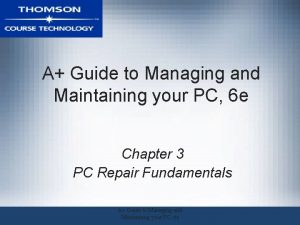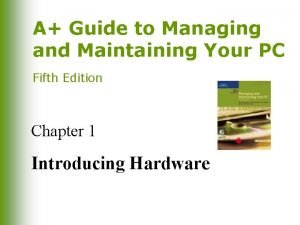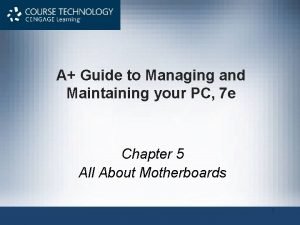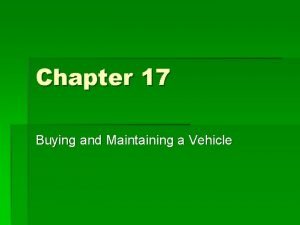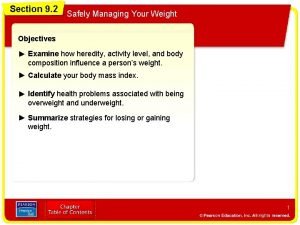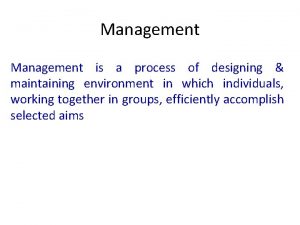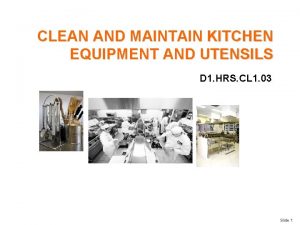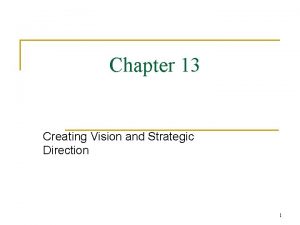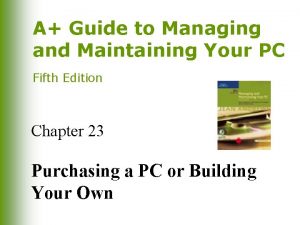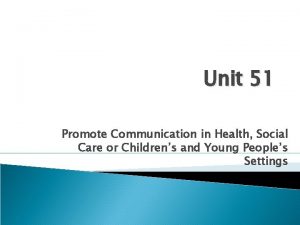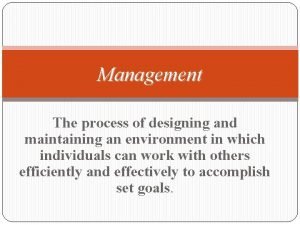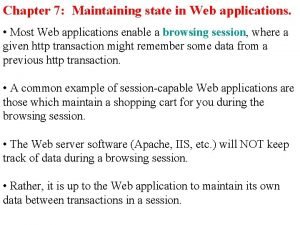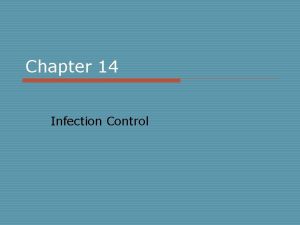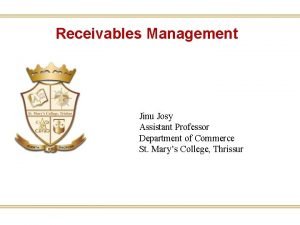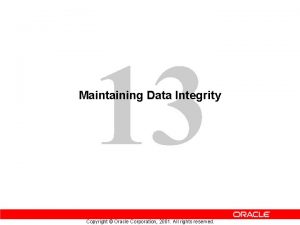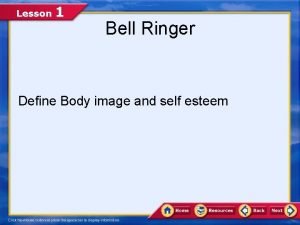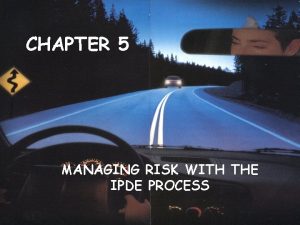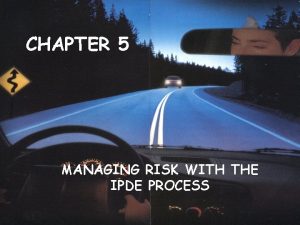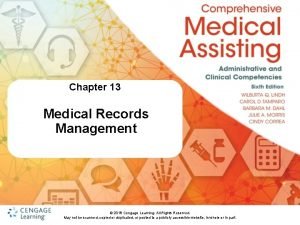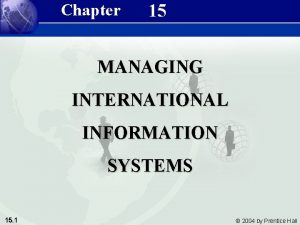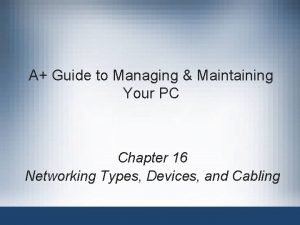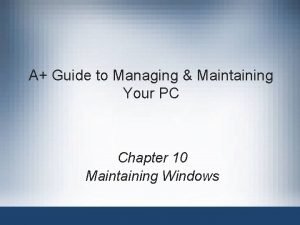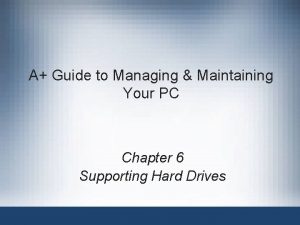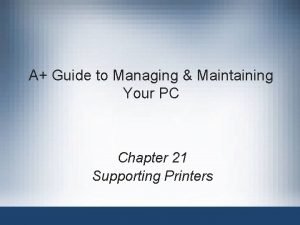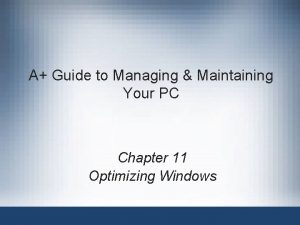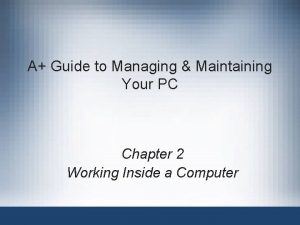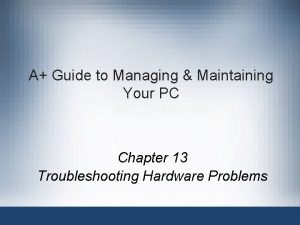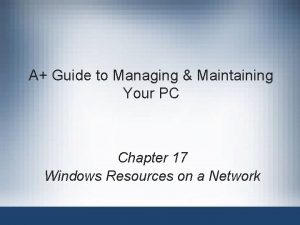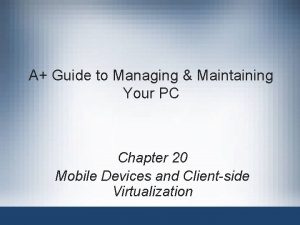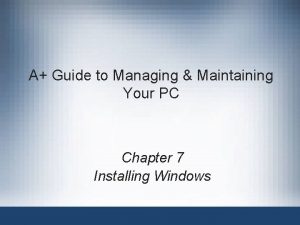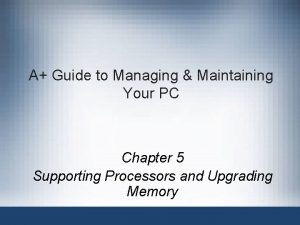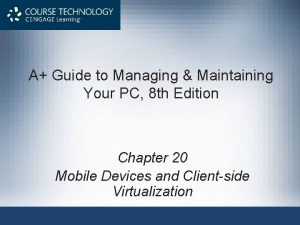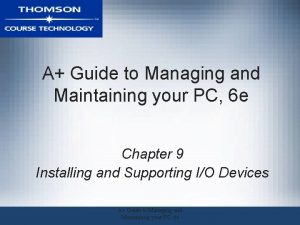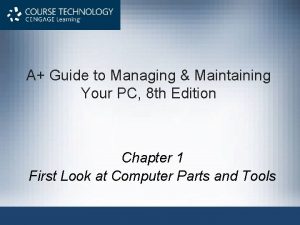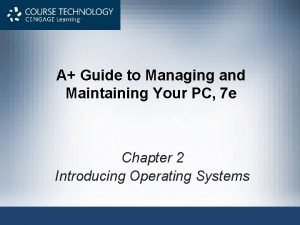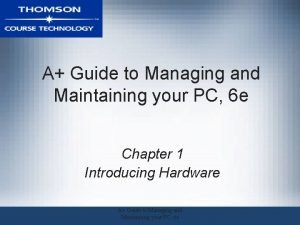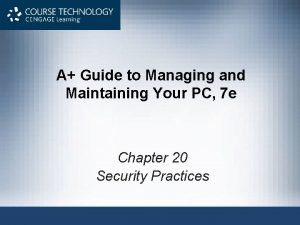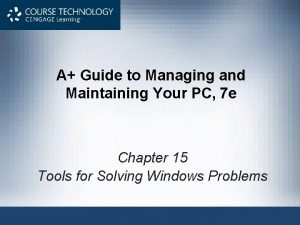A Guide to Managing Maintaining Your PC Chapter
































































- Slides: 64

A+ Guide to Managing & Maintaining Your PC Chapter 14 Troubleshooting Windows Startup Problems

Objectives • Learn about the boot process from the time you press the power button until the Windows desktop loads • Learn about Windows tools that can help when solving Windows startup problems • Learn how to troubleshoot Windows startup problems A+ Guide to Managing & Maintaining Your PC, 8 th Edition © Cengage Learning 2014 2

Understanding The Boot Process • Choosing between a hard boot and a soft boot – Hard boot (cold boot): turning on the power with the on/off switch • Takes more time than a soft boot • Initializes the processor and clears memory – Soft boot (warm boot): using the OS to reboot • To save time use the soft boot to restart • If a soft boot doesn’t work, use a hard boot A+ Guide to Managing & Maintaining Your PC, 8 th Edition © Cengage Learning 2014 3

Startup BIOS Controls The Beginning Of The Boot • Startup BIOS: responsible for getting a system up and running • A successful boot depends on the hardware, the BIOS, and the OS performing without errors • Startup BIOS is responsible for: – Reads motherboard settings and runs the POST – Setup BIOS might be run (if key is pressed to request) – Startup BIOS searches for a bootable device A+ Guide to Managing & Maintaining Your PC, 8 th Edition © Cengage Learning 2014 4

Figure 14 -2 Use BIOS setup screens to change the hardware configuration for a system A+ Guide to Managing & Maintaining Your PC, 8 th Edition © Cengage Learning 2014 5

Steps To Start Windows 7/Vista • The following table lists the components and files necessary to start Windows 7/Vista Table 6 -1 Software components and files needed to start Windows 7/Vista A+ Guide to Managing & Maintaining Your PC, 8 th Edition © Cengage Learning 2014 6

Table 6 -1 Software components and files needed to start Windows 7/Vista (continued) A+ Guide to Managing & Maintaining Your PC, 8 th Edition © Cengage Learning 2014 7

Figure 14 -3 Steps to booting the computer and loading Windows 7/Vista A+ Guide to Managing & Maintaining Your PC, 8 th Edition © Cengage Learning 2014 8

Figure 14 -4 Steps to complete loading Windows 7/Vista A+ Guide to Managing & Maintaining Your PC, 8 th Edition © Cengage Learning 2014 9

Windows 7/Vista Tools for Solving Startup Problems • Windows tools to solve startup problems – Advanced Boot Options menu – Windows Recovery Environment (Windows RE) – Command prompt window in Windows RE A+ Guide to Managing & Maintaining Your PC, 8 th Edition © Cengage Learning 2014 10

Advanced Boot Options Menu • Press F 8 as Windows loads • Repair Your Computer – Only available in Windows 7 – Launches Windows Recovery Environment • Safe Mode boots a minimum configuration OS – – – Uses default system services No network access Uses a plain video driver “Safe Mode” appears in four corners of the screen Screen resolution: 800 x 600 Desktop wallpaper (background): black A+ Guide to Managing & Maintaining Your PC, 8 th Edition © Cengage Learning 2014 11

Figure 14 -11 Safe Mode loads a minimum Windows configuration A+ Guide to Managing & Maintaining Your PC, 8 th Edition © Cengage Learning 2014 12

Advanced Boot Options Menu • Recovering the system using Safe Mode – Use System restore – Scan system for virus and run Memory Diagnostics and Chkdsk – Use Device Manager to uninstall, disable a device with problems, or roll back a driver – Use System Configuration (Msconfig) to disable unneeded services or startup processes – Use Programs and Features window to uninstall software – Use Event Viewer to find information about previously failed startups A+ Guide to Managing & Maintaining Your PC, 8 th Edition © Cengage Learning 2014 13

Advanced Boot Options Menu • Tips about loading Safe Mode – Form Advanced Boot Options menu • First, try Safe Mode with Networking • Next, try Safe Mode • Then, try Safe Mode with Command prompt – Safe Mode won’t load if core Windows components are corrupted – When loading Windows in Safe Mode • All files used for the load are recorded in Ntbtlog. txt file • File might identify service, device driver, or application loaded at startup causing a problem A+ Guide to Managing & Maintaining Your PC, 8 th Edition © Cengage Learning 2014 14

Advanced Boot Options Menu • Safe mode with networking – Use when solving a problem with booting and network access is needed – Also use when the Windows installation files are available on the network • Safe mode with command prompt – Use the sfc /scannow command to verify system files – Use the chkdsk /r command to check for file system errors – If problem not solved, launch System Restore A+ Guide to Managing & Maintaining Your PC, 8 th Edition © Cengage Learning 2014 15

Figure 14 -12 SFC finds and repairs corrupted system files A+ Guide to Managing & Maintaining Your PC, 8 th Edition © Cengage Learning 2014 16

Figure 14 -13 Use System Restore after booting to Safe Mode with Command Prompt A+ Guide to Managing & Maintaining Your PC, 8 th Edition © Cengage Learning 2014 17

Advanced Boot Options Menu • Enable boot logging – Windows loads normally with regular desktop – All files used during load process are recorded • C: WindowsNtbtlog. txt Figure 14 -14 Sample Ntbtlog. txt file A+ Guide to Managing & Maintaining Your PC, 8 th Edition © Cengage Learning 2014 18

Advanced Boot Options Menu • Enable low-resolution video (640 x 480) – Used when video setting does not allow screen to display clearly to fix a bad setting – Windows XP, option is called “Enable VGA Mode” • Last known good configuration – Saved in registry after each successful logon – Can undo a bad installation and solve the problem – Try the Last Known Good early in troubleshooting, before it’s overwritten • When logging onto the system in Safe Mode, the Last Known Good not saved A+ Guide to Managing & Maintaining Your PC, 8 th Edition © Cengage Learning 2014 19

Advanced Boot Options Menu • Directory services restore mode (Windows Domain controllers only) – Used as one step in the process of recovering from a corrupted Active Directory • Debugging mode – Can move system boot logs from failing computer to another computer for evaluation • Disable automatic restart on system failure – Stop rebooting upon encountering a system failure A+ Guide to Managing & Maintaining Your PC, 8 th Edition © Cengage Learning 2014 20

The Windows Recovery Environment (Windows RE) • Operating system launched from the Advanced Boot Options menu – Provides graphical and command-line interfaces • To launch Windows RE – Boot from Windows 7 or Vista setup DVD, and select language preference – In Windows 7, it is installed on the hard drive and available from the Advanced Boot Options menu – A Windows 7 system repair disc can be created and can be used to launch Windows RE A+ Guide to Managing & Maintaining Your PC, 8 th Edition © Cengage Learning 2014 21

Figure 14 -15 Use Backup and Restore to create a system repair disc to use instead of Windows setup DVD A+ Guide to Managing & Maintaining Your PC, 8 th Edition © Cengage Learning 2014 22

The Windows Recovery Environment (Windows RE) • After Windows RE is launched the System Recovery Options box offers several recovery tool options Figure 14 -18 Recovery Tools in Windows RE for Windows 7 A+ Guide to Managing & Maintaining Your PC, 8 th Edition © Cengage Learning 2014 23

The Windows Recovery Environment (Windows RE) • Use the least intrusive tools first • Use these Windows RE tools in the order listed: – 1. Startup Repair – least intrusive • Does not change data or installed applications Figure 14 -20 Startup Repair suggests you use System Restore A+ Guide to Managing & Maintaining Your PC, 8 th Edition © Cengage Learning 2014 24

The Windows Recovery Environment (Windows RE) • Use these Windows RE tools in the order listed: – 2. Windows Memory Diagnostic • Use if memory is suspected to be a problem – 3. System Restore • Can sometimes fix a problem with a corrupted device driver, corrupted Windows settings, or corrupted programs – 4. Command Prompt • Use this option to run chkdsk or restore a corrupted registry from the Command Prompt window – 5. System Image Recovery – last resort • Will erase everything and restore previous image A+ Guide to Managing & Maintaining Your PC, 8 th Edition © Cengage Learning 2014 25

The Windows Recovery Environment (Windows RE) • In Vista, the Complete PC Restore option is available instead of the Windows 7 option of System Image Recovery Figure 14 -23 Recovery Tools in Windows RE for Windows Vista A+ Guide to Managing & Maintaining Your PC, 8 th Edition © Cengage Learning 2014 26

The Command Prompt Window in Windows RE • Use when graphical tools available in Windows RE fail to solve the problem – Offers full read and write access to all files on the drives • Repair a hard drive or other drive – Use chkdsk and format commands to repair a drive – Use diskpart to manage hard drives, partitions, and volumes • Refer to table on the next slide which lists important diskpart commands A+ Guide to Managing & Maintaining Your PC, 8 th Edition © Cengage Learning 2014 27

Table 6 -2 Important diskpart commands used at the DISKPART> prompt A+ Guide to Managing & Maintaining Your PC, 8 th Edition © Cengage Learning 2014 28

Figure 14 -24 Use commands in diskpart to partition and format a USB flash drive A+ Guide to Managing & Maintaining Your PC, 8 th Edition © Cengage Learning 2014 29

The Command Prompt Window in Windows RE • Enable networking – Networking is not normally available – Use the wpeinit command to enable networking • Repair the file system and key boot files – Use the bootrec command to repair the BCD and boot sectors – Use the bcdedit command to manually edit the BCD – Use the bootsect command to repair a dual boot system A+ Guide to Managing & Maintaining Your PC, 8 th Edition © Cengage Learning 2014 30

Table 6 -3 Commands used in the command prompt window of Windows RE to repair system files and the file system A+ Guide to Managing & Maintaining Your PC, 8 th Edition © Cengage Learning 2014 31

The Command Prompt Window in Windows RE • Manage data files and system files – Use cd, copy, rename, and delete commands – Restore registry files using those saved in the Reg. Back folder – After each fix, reboot the system to see if problem was solved – Use commands in Table 6 -4 (see next slide) to restore registry files A+ Guide to Managing & Maintaining Your PC, 8 th Edition © Cengage Learning 2014 32

Table 6 -4 Steps to restore the registry files A+ Guide to Managing & Maintaining Your PC, 8 th Edition © Cengage Learning 2014 33

Troubleshooting Windows 7/Vista Startup • To determine where in the boot process the failure occurred, focus on three startup stages of the boot – Stage 1: Before the progress bar – Stage 2: After the progress bar and before logon – Stage 3: After logon A+ Guide to Managing & Maintaining Your PC, 8 th Edition © Cengage Learning 2014 34

Problems At Stage 1: Before The Flag Or Progress Bar Appears • Problems might be caused by hardware or startup files • Is the screen blank? If nothing is on the screen: – Monitor LED light lit • Reboot, check monitor power, and that it is on – Monitor LED light is not lit • Verify system power, monitor is plugged in and on – If hard drive is not spinning suspect no power is getting to system • Verify system not in standby mode or hibernation – Trade monitor for a good one A+ Guide to Managing & Maintaining Your PC, 8 th Edition © Cengage Learning 2014 35

Problems At Stage 1: Before The Flag Or Progress Bar Appears • Does the computer appear to have power? – Can’t hear spinning drive or see lights on case front • • Suspect electrical system Check power connections and switches May have bad power supply Loose connections inside case A+ Guide to Managing & Maintaining Your PC, 8 th Edition © Cengage Learning 2014 36

Problems At Stage 1: Before The Flag Or Progress Bar Appears • Does an error message appear before Windows starts? – BIOS displays error message on-screen if problem is detected • Uses beeps or speech if video not working – On-screen messages for nonessential hardware • Try to bypass error by pressing a key and moving forward in the boot – On-screen messages for essential hardware • Focus attention on the error message, beep code, and voice message describing problem A+ Guide to Managing & Maintaining Your PC, 8 th Edition © Cengage Learning 2014 37

Figure 14 -25 This error message at POST indicates a hardware problem A+ Guide to Managing & Maintaining Your PC, 8 th Edition © Cengage Learning 2014 38

Problems At Stage 1: Before The Flag Or Progress Bar Appears • Can startup BIOS access the hard drive? – Possible messages • • Hard drive not found Fixed disk error Disk boot failure, insert system disk and press enter No boot device available – Check for physical problem • Drive, data cable, power, motherboard – Verify BIOS detected drive correctly • Turn on autodetection and reboot – Power down system, unplug it, and physically inspect A+ Guide to Managing & Maintaining Your PC, 8 th Edition © Cengage Learning 2014 39

Problems At Stage 1: Before The Flag Or Progress Bar Appears • Can startup BIOS access the hard drive? (cont’d. ) – BIOS found hard drive, but could not read drive • • A disk read error occurred Drive not recognized Invalid boot disk Inaccessible boot device Invalid drive specification Invalid partition table Operating system not found Could not find bootmgr or bootmgr missing – Boot from Windows setup DVD (see next slide) A+ Guide to Managing & Maintaining Your PC, 8 th Edition © Cengage Learning 2014 40

Problems At Stage 1: Before The Flag Or Progress Bar Appears • Use BIOS setup to set the boot sequence – Access BIOS setup utility – Find screen to change boot sequence – Make sure DVD drive is listed before hard drive • Force system to boot from Windows Vista setup DVD – Save settings and exit BIOS setup A+ Guide to Managing & Maintaining Your PC, 8 th Edition © Cengage Learning 2014 41

Figure 14 -26 Set the boot order in BIOS setup A+ Guide to Managing & Maintaining Your PC, 8 th Edition © Cengage Learning 2014 42

Problems At Stage 1: Before The Flag Or Progress Bar Appears • Can you boot from the Windows setup DVD? – If not then study error messages, and solve immediate hardware problem • Hard drive and optical drive might have failed • Try a bootable USB flash drive • Successful boot from flash drive indicates problem with both the hard drive and DVD drive – If able to boot from Windows DVD • Windows logon screen appears • Problem isolated to the hard drive A+ Guide to Managing & Maintaining Your PC, 8 th Edition © Cengage Learning 2014 43

Problems At Stage 1: Before The Flag Or Progress Bar Appears • Can Windows RE find the Windows installation? – Launch Windows RE • Windows RE attempts to locate Windows installation on the hard drive – If Windows RE cannot locate the installation, but BIOS setup recognizes the drive • Drive partitions and file systems might be corrupted – If Windows RE does locate the installation • Problem likely limited to corrupted or missing system files or drivers – Attempt fixes: restart system after each step A+ Guide to Managing & Maintaining Your PC, 8 th Edition © Cengage Learning 2014 44

Problems At Stage 1: Before The Flag Or Progress Bar Appears • Can Windows RE find the Windows installation? (cont’d. ) – Run Startup Repair • Sometimes fixes drastic problems with system files, boot records – Run System Restore • Process won’t help if file system corrupted – Restart system and launch Advanced Boot Options menu • No boot menu: problem may be corrupted boot sector • Boot menu appears: probable BCD file or other startup file problem A+ Guide to Managing & Maintaining 45 Your PC, 8 th Edition © Cengage Learning 2014

Problems At Stage 1: Before The Flag Or Progress Bar Appears • Can Windows RE find the Windows installation? (cont’d. ) – Restart system, launch Advanced Boot Options menu (cont’d. ) • If boot menu appears: enable boot logging and reboot • Check boot log (Windowsntbtlog. txt) for the last entry • Might indicate which system file missing or corrupt – If boot menu does not appear: • Return to Windows RE, launch command prompt window, and attempt to repair boot sector A+ Guide to Managing & Maintaining Your PC, 8 th Edition © Cengage Learning 2014 46

Problems At Stage 1: Before The Flag Or Progress Bar Appears • Can Windows RE find the Windows installation? (cont’d. ) – If boot menu does appear: • Return to Windows RE, launch command prompt window, and attempt to repair the BCD file – Try to repair corrupted file system • Use command prompt window and chkdsk c: /r command – When startup files missing or corrupt • Windows may display an error message A+ Guide to Managing & Maintaining Your PC, 8 th Edition © Cengage Learning 2014 47

Figure 14 -28 Windows might display a screen similar to this one when a critical startup file is missing or corrupt A+ Guide to Managing & Maintaining Your PC, 8 th Edition © Cengage Learning 2014 48

Problems At Stage 1: Before The Flag Or Progress Bar Appears • Can Windows RE find the Windows installation? (cont’d. ) – Use command prompt window to access drive C • Get to C prompt: use DIR command to list folders and files • Good list: check log file for clues • Not a good list: most likely Vista installation destroyed beyond repair • Make every effort to copy data to another media A+ Guide to Managing & Maintaining Your PC, 8 th Edition © Cengage Learning 2014 49

Problems At Stage 1: Before The Flag Or Progress Bar Appears • Options to recover from a corrupted Windows installation – Option 1: Complete PC backup available • Restore system to last backup – Option 2: Complete PC backup not available and data backups available on hard drive • Install Windows, format hard drive during installation, install applications again, restore data – Option 3: Complete PC backup and data backup not available • Try to copy data to removable device and reinstall Windows A+ Guide to Managing & Maintaining Your PC, 8 th Edition © Cengage Learning 2014 50

Problems At Stage 1: Before The Flag Or Progress Bar Appears • Steps to reinstall Windows • Follow these steps when OS refuses to boot and important data on the drive: – Boot from Windows setup DVD • Follow directions on-screen to install the OS – If you suspect hard drive might be failing, reformat the hard drive and reinstall Windows – If you suspect a healthy hard drive • • Run Chkdsk to fix errors Install applications and device drivers Create all user accounts and customize Vista settings Delete the Windows. Old folder A+ Guide to Managing & Maintaining Your PC, 8 th Edition © Cengage Learning 2014 51

Problems At Stage 2: After The Flag Or Progress Bar Appears/Before Logon • Microsoft progress bar appears during the boot – Windows kernel loaded successfully – Critical drivers and services configured to be started by the kernel running – Session Manager (Smss. exe) running in user mode started the Win 32 subsystem – If logon screen not displayed: • Probable corrupted driver or service started after kernel finished its part of the boot • Fix by isolating and disabling Windows component, service, or application causing trouble A+ Guide to Managing & Maintaining Your PC, 8 th Edition © Cengage Learning 2014 52

Problems At Stage 2: After The Flag Or Progress Bar Appears/Before Logon • Follow these steps: – 1. Launch Advanced Boot Options and try to boot into Safe Mode • • Immediately run antivirus software Run Chkdsk c: /r Examine all logs in Event Viewer Use MSconfig to stop applications just installed, then uninstall and reinstall Use System Information (msinfo 32. exe) Use Device Manager to check for hardware errors Use the System File Checker (SFC) tool Rename the WindowsNtbtlog. txt file A+ Guide to Managing & Maintaining Your PC, 8 th Edition © Cengage Learning 2014 53

Problems At Stage 2: After The Flag Or Progress Bar Appears/Before Logon • Follow these steps: (cont’d) – 2. If cannot boot into Safe Mode, select Last Known Good Configuration on the Advanced Boot Options menu – 3. Launch Windows RE and run Startup Repair from the System Recovery Options menu – 4. In Windows RE, run System Restore • Select the latest restore point • If that doesn’t fix the problem, try an earlier one – 5. Boot to Advanced Boot Options menu and select Enable Boot Logging A+ Guide to Managing & Maintaining Your PC, 8 th Edition © Cengage Learning 2014 54

Problems At Stage 2: After The Flag Or Progress Bar Appears/Before Logon • Follow these steps: (cont’d) – 6. Compare the Ntbtlog. txt file to one that was created in Safe Mode to find what caused error – 7. If you can boot into Safe Mode, use Device Manager to disable the device or use Services console to disable the service – 8. If you cannot boot into Safe Mode, open command prompt window in Windows RE • Back up registry, find key that loads services and drivers A+ Guide to Managing & Maintaining Your PC, 8 th Edition © Cengage Learning 2014 55

Problems At Stage 2: After The Flag Or Progress Bar Appears/Before Logon • Follow these steps: (cont’d) – 9. Disable service or driver by changing Start value to 0 x 4 • Reboot, replace program file, and restart service or driver A+ Guide to Managing & Maintaining Your PC, 8 th Edition © Cengage Learning 2014 56

Problems At Stage 3: After Windows Logon • Problems caused by applications or services configured to launch at startup – Shortcuts in startup folders, Scheduled Tasks, or software installation processes affecting registry entries – Error message at startup • Disable program using MSconfig A+ Guide to Managing & Maintaining Your PC, 8 th Edition © Cengage Learning 2014 57

Figure 14 -5 Error messages during Windows startup and what to do about them (continues) A+ Guide to Managing & Maintaining Your PC, 8 th Edition © Cengage Learning 2014 58

Figure 14 -5 Error messages during Windows startup and what to do about them (continued) A+ Guide to Managing & Maintaining Your PC, 8 th Edition © Cengage Learning 2014 59

How to Recover Lost Data • Use Windows tools, third party software, or commercial data recovery services • Recovering a deleted or corrupted data file – Look in the Recycle Bin – Restore it from backup using the Backup and Restore window or use Previous Versions tab on file’s Properties box – Use the Recover command – Use application manufacturer’s web site – Use third party software A+ Guide to Managing & Maintaining Your PC, 8 th Edition © Cengage Learning 2014 60

How to Recover Lost Data • Recover data from a computer that will not boot – Remove hard drive and install as a second nonbooting hard drive in another system – Use IDE to USB or a SATA to USB converter kit • Temporarily connect hard drive to a USB port on a working computer • Browse drive and copy data using Windows Explorer • Use a data recovery service – Search for “data recovery” on the Internet – Read up on reviews, understand warranty and guarantees, and get a recommendation A+ Guide to Managing & Maintaining Your PC, 8 th Edition © Cengage Learning 2014 61

Summary • When a system is turned on, startup BIOS takes control to examine hardware components and find an OS to load • Windows 7/Vista startup is managed by Windows Boot Manager(Boot. Mgr) and Windows Boot Loader (Win. Load. exe) • Advanced Boot Options menu offers many options that are useful when troubleshooting startup problems A+ Guide to Managing & Maintaining Your PC, 8 th Edition © Cengage Learning 2014 62

Summary • Windows Recovery Environment (Windows RE) includes tools such as System Repair, Memory Diagnostics, System Restore, a command prompt window, and System Image Recovery • Windows tools and techniques used to troubleshoot a failed boot include Last Known Good Configuration, Startup Repair, System Restore, Safe Mode, Command Prompt, in-place upgrade of Windows, reimaging the hard drive, and reinstalling Windows A+ Guide to Managing & Maintaining Your PC, 8 th Edition © Cengage Learning 2014 63

Summary • In a failed Windows boot, it is important to determine at what point in the boot the failure occurred • If a hard drive will not boot, data recovery might be possible by installing the drive in another system as a second, nonbooting hard drive A+ Guide to Managing & Maintaining Your PC, 8 th Edition © Cengage Learning 2014 64
 Guide to managing and maintaining your pc
Guide to managing and maintaining your pc Guide to managing and maintaining your pc
Guide to managing and maintaining your pc Guide to managing and maintaining your pc
Guide to managing and maintaining your pc Managing your own business
Managing your own business Chapter 17 maintaining your vehicle
Chapter 17 maintaining your vehicle How to maintain your deliverance
How to maintain your deliverance Chapter 16 managing the stress in your life
Chapter 16 managing the stress in your life Chapter 15:5 sterilizing with an autoclave
Chapter 15:5 sterilizing with an autoclave Chapter 11 lesson 2 body image and eating disorders
Chapter 11 lesson 2 body image and eating disorders Give us your hungry your tired your poor
Give us your hungry your tired your poor Managing your personal finances textbook answers
Managing your personal finances textbook answers Managing your online identity
Managing your online identity Managing your payables
Managing your payables Managing your weight part 2
Managing your weight part 2 Types of records in hospital
Types of records in hospital The process of designing and maintaining an environment
The process of designing and maintaining an environment Building and maintaining a website
Building and maintaining a website Cleaning equipment for crockery
Cleaning equipment for crockery Components of retail image
Components of retail image Establishing and maintaining a retail image
Establishing and maintaining a retail image Maintaining a healthy body composition and body image
Maintaining a healthy body composition and body image Maintaining a professional image
Maintaining a professional image Class maintaining suffixes
Class maintaining suffixes Creating vision and strategic direction
Creating vision and strategic direction Purchasing and maintaining a computer
Purchasing and maintaining a computer Potential tension between maintaining confidentiality
Potential tension between maintaining confidentiality Maintaining a teachable spirit
Maintaining a teachable spirit Maintaining a website
Maintaining a website Access module 3 maintaining a database
Access module 3 maintaining a database The process of designing and maintaining an environment
The process of designing and maintaining an environment Social order maintaining orientation
Social order maintaining orientation Maintaining effective partnerships
Maintaining effective partnerships Maintaining state in web applications
Maintaining state in web applications Maintaining transmission based isolation precautions
Maintaining transmission based isolation precautions Maintaining ecological balance
Maintaining ecological balance Cost of maintaining receivables
Cost of maintaining receivables Homeostasis blood calcium level
Homeostasis blood calcium level Maintaining a healthy body composition and body image
Maintaining a healthy body composition and body image Maintaining student privacy
Maintaining student privacy Building and maintaining customer relationships
Building and maintaining customer relationships The way you see your body
The way you see your body Data integrity in oracle
Data integrity in oracle Maintaining curiosity
Maintaining curiosity Maintaining a healthy body composition and body image
Maintaining a healthy body composition and body image Maintaining information systems
Maintaining information systems Chapter 1 managing risk when driving
Chapter 1 managing risk when driving Chapter 8 managing stress and anxiety
Chapter 8 managing stress and anxiety Chapter 4 managing stress and coping with loss
Chapter 4 managing stress and coping with loss Distractions outside a vehicle are more easily managed
Distractions outside a vehicle are more easily managed Chapter 8 managing distractions answers
Chapter 8 managing distractions answers Chapter 6 managing weight and body composition
Chapter 6 managing weight and body composition Managing risk with the ipde process
Managing risk with the ipde process Write the terms associated with ipde process chapter 5
Write the terms associated with ipde process chapter 5 Chapter 4 managing stress and coping with loss
Chapter 4 managing stress and coping with loss Ipde process definition
Ipde process definition Managing in a global environment
Managing in a global environment Chapter 18 managing anxiety
Chapter 18 managing anxiety Chapter 17 managing business finances
Chapter 17 managing business finances Chapter 17 managing business finances
Chapter 17 managing business finances Chapter 13 medical records management
Chapter 13 medical records management Extreme harmful eating behaviors
Extreme harmful eating behaviors Managing global systems chapter 15
Managing global systems chapter 15 Chapter 1 managers and managing
Chapter 1 managers and managing Managing weight and eating behaviors
Managing weight and eating behaviors Managing in a global environment chapter 4
Managing in a global environment chapter 4
